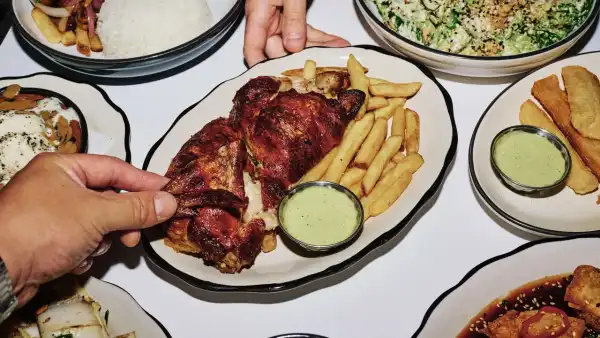
Save this storySave this storySave this storySave this storyYou’re perusing the Food Scene bulletin, Helen Rosner’s manual for what, where, and how to dine. Join to get it delivered to your mailbox.
Johnny’s, a spick-and-span eatery that debuted in East Williamsburg this past July, is known for chifa, a Sino-Peruvian melding that stands as one of the globe’s premier comfort fare options: dumplings, sautés, arroz chaufa, the smoky rotisserie fowl recognized as pollo a la brasa, and a never-ending deluge of aji verde, a piquant, cilantro-filled green-chili condiment—all of it rich, bold, and gratifying. The eating house takes its name from the departed father of the proprietors, the sister-and-brother duo Stephanie Tang and John Tang. Johnny acquired the craft of pollo a la brasa from his own progenitor, Yuen Jam Tan, who relocated his family from Hong Kong to Peru in the nineteen-sixties, mastered the skill of the rotisserie, and thereupon, in the seventies, ferried it to Queens. In a recent discussion, Stephanie confided in me that Tan’s initial eatery, Peking BBQ, in Woodside, remains operational, currently managed by one of her maternal uncles. According to her gauge, there exist roughly a dozen rotisserie restaurants scattered across the New York City region handled by cohorts of her vast clan. The majority are “somewhat humble establishments,” Stephanie noted: pared-down, bustling storefronts concentrated on takeout and rapid service. Her mother, who presides over a pair of rotisserie restaurants, one in New Jersey and another in Sunset Park, was hoping to inaugurate a secondary Brooklyn venue when she stumbled upon this corner spot in Williamsburg. Stephanie, who has a daytime position in the fashion sector and dwells only a handful of blocks away from the street corner that morphed into Johnny’s, began to conceive of something distinct from the time-honored convention. The locale would still be relaxed, yet it would additionally be a sit-down restaurant, complete with mixed drinks, appealing illumination, artwork embellishing the walls, an atmosphere—why not encase chifa in chicer, upscale adornments?
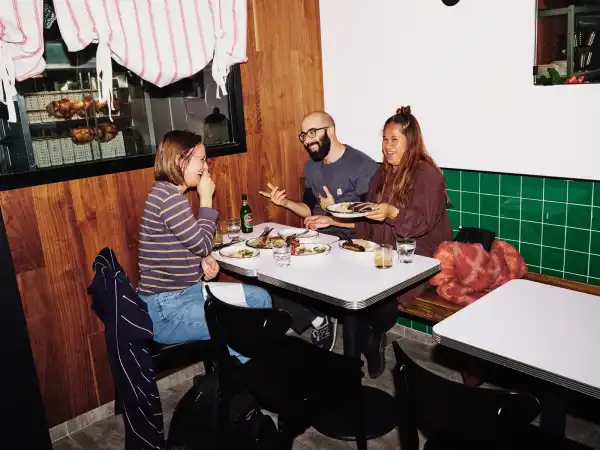
Birds are visible through a window from the dining room.
Why shouldn’t it? Chifa is not particularly ornate, yet there’s no justification for a bronzed, halved bird or succulent, vinegar-sauced spare ribs to be deprived of an exquisite presentation. The chamber is capacious and with lofty ceilings, showcasing expansive portals permitting the shimmering radiance of cars on the neighboring B.Q.E. to seep in. A timbered banquette unfolds along the bounds, and tables are arranged intimately enough that witnessing the jalea (a mammoth dish of sautéed shellfish) at a nearby table might encourage you to order it, yet providing plentiful space for the eatery to introduce supplementary tables as popularity swells. A polished, arched bar, integrated into the epicenter of the chamber, yields a point of focus: a plush llama sculpture overseeing from a high ledge, a duo of frosty machines atop the counter consistently in motion. One serves as a frozen Pisco Sour enlivened with lychee; the other, a gauzy bloom-petal magenta, constitutes chicha morada, a beverage concocted from purple maize enriched with cinnamon and cloves. (Sample them while they’re available: by Stephanie’s account, a fresh beverage assortment void of the frozen picks is soon being rolled out.)
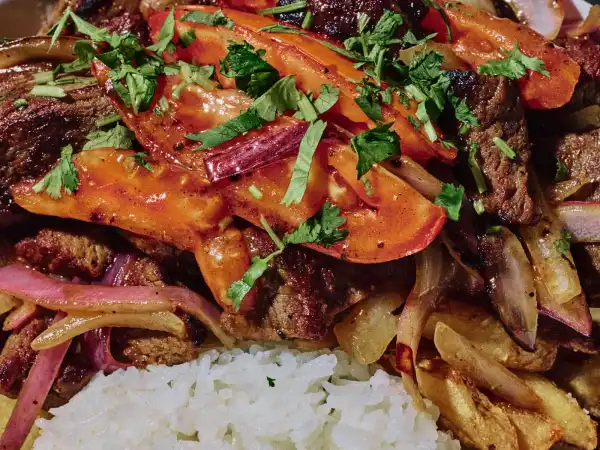
The lomo saltado sits on a pile of fries.
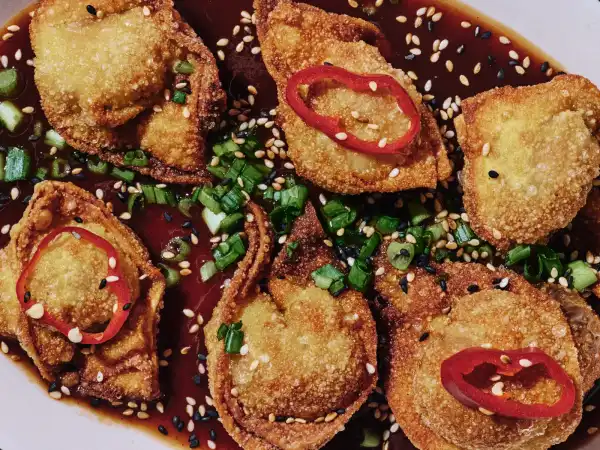
The kam lu wantan gets an elegant presentation.
The cuisine, as well, contributes some clever re-conceptualization. Kam lu wantan, for example, is a quintessential chifa creation of flash-fried dumplings that are merged in a sugar-and-vinegar dressing containing meat and produce. At Johnny’s, they surface with all of the customary elements in a radically altered sequence. Only the dumplings contain meat, which remain flash-fried (perhaps a hair more than necessary), displayed in a stylish manner upon a stroke of the sauce, and topped with jaunty, diminutive circles of crimson chili. Lomo saltado, a strikingly Peruvian steak stir-fry that has usually come with fries, is offered with the fries cloaked beneath tender beef and onions, absorbing every one of the savory extracts and rendering an adjunct portion of fluffy white rice appear bordering on extraneous. Generally, tomatoes are lightly fried inside a wok alongside the steak and onions, their essence intensifying and mellowing. In this instance, hefty, luminous cuts of tomato are barely cooked; situated atop the beef, they impart a lively, tangy punch.
Helen, Help Me!
Dispatch your inquiries regarding dining, consuming, and anything culinary-related, and Helen might address them in an upcoming bulletin.
Nevertheless, we gather for the poultry. A handful of dozens of birds are observable, by means of a plate-glass overlook of the cooking area, gradually pivoting on parallel railings before a charcoal blaze. No spellbinding effect quite parallels the ever-whirling motion of the rotisserie: limbs upward, limbs downward, the barely perceptible deepening of the epidermis’s hue, the tempting gushing of molten fat. Stephanie Tang communicated to me that her kinfolk have agreed upon approximately three pounds as the optimal scale for a specimen: anything heftier, and the apportionment of char to flesh wanders out of proportion; anything tinier, and it courts the likelihood of drying out as it cooks. At Johnny’s, similarly to the multitude of the family’s eateries, the kitchen deploys a fundamentally unchanged rendition of her grandfather’s marinade. It’s mellow, boasting a trace of cumin and a dash of garlic, conceivably to avert dominating the other star of the performance: aji verde. Following the fulfillment of a repast at Johnny’s your table will be strewn with miniature metallic vessels of the substance. It also accompanies the ribs; beside the starchy yucca chips and the delectable, gilded tostones; as well as the velvety, chicken-like croquettes that fashion a superlative kickoff to the meal. (I am quite gladdened to notice croquettes materializing increasingly on menus—they are the impeccable bite-size offering, and such a gratifying avenue for gastronomic remnants. It’s regrettable that Americans haven’t rendered them as widespread a hors d’oeuvre as sliders or mozzarella fingers.)
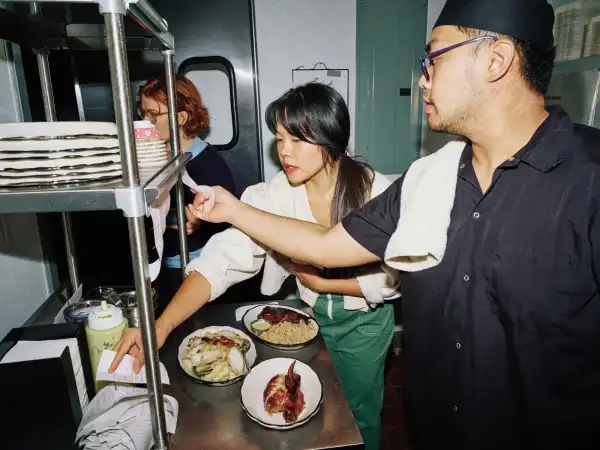
The sister-and-brother pair Stephanie Tang and John Tang own the retaurant. Members of their extended family run about a dozen other rotisserie restaurants in the N.Y.C. area.
No eating place is pristine, yet Johnny’s verges rather intimate. It’s welcoming and straightforward. The dishes are astute and consistent. The allotments are abundant. The expenses are exceedingly fair: every item featured on the menu is priced below thirty bucks, and a quarter chicken combination, furnished with a mountain of vibrant-tasting vegetable-infused arroz chaufa and a crisp edge salad, is a respectable nineteen dollars. While a reasonable quantity of seating appears to be tenanted by vogue-pursuing diner-goers and cross-borough foodies, the locale emits the unmistakable feel of a genuine neighborhood sanctuary; were I to reside closer, I surmise I would frequent it perpetually. It instills comfort, intimacy, a repast molded by the Tang siblings’ ancestral saga, assuredly, as well as by their singular inclinations and eccentricities. A sesame-fortified Caesar salad is augmented with crushed saltines. Aluminum containers of effervescent yerba maté originate from the autonomous Hong Kong soda manufacturer Mezzanine Makers, and alcoholic potables are mischievously arrayed with cocktail parasols. Merely a solitary sweet offering graces the menu, a tacky-cored skillet confection, surmounted by a scoop of frozen dessert and trickles of pitch-sesame caramel and dulce de leche. Upon my inquiry to Stephanie Tang as to whether that, too, was derived from the chifa compendium, she giggled and pronounced, “Candidly, I just possess a profound affection for a chocolate-chip cookie.” ♦
Sourse: newyorker.com







